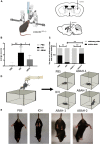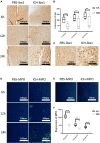Effects and mechanism of myeloperoxidase on microglia in the early stage of intracerebral hemorrhage
- PMID: 36570834
- PMCID: PMC9783921
- DOI: 10.3389/fnins.2022.1046244
Effects and mechanism of myeloperoxidase on microglia in the early stage of intracerebral hemorrhage
Abstract
Objectives: (1) To clarify the dynamic relationship between the expression of myeloperoxidase (MPO) and microglial activation of intracerebral hemorrhage (ICH), (2) to explore the effect of inhibition of MPO on microglial activation, and (3) to observe the improvement in the neurobehavior of mice with inhibition of MPO.
Methods: C57 BL/6 mice and CX3CR1 + /GFP mice were used to establish a phosphate-buffered saline (PBS) group, an ICH group, and a 4-aminobenzoic acid hydrazide (ABAH) group. Longa score, open field locomotion, hind-limb clasping test, immunohistochemistry, immunofluorescence, blood routine detection, and flow cytometry were used.
Results: The neurobehavior of the mice was significantly impaired following ICH (P < 0.01); the expression of MPO was significantly increased following ICH, and reached a peak value at 6 h post-injury (P < 0.001). Moreover, the microglial activation increased significantly following ICH, and reached a peak level at 24 h post-injury (P < 0.01). Following inhibition of MPO, the activation of microglia in the ICH group decreased significantly (P < 0.001). Moreover, the neurobehavior of the ICH group was significantly improved with MPO inhibition (P < 0.05).
Conclusion: MPO may be an upstream molecule activated by microglia and following inhibition of MPO can improve secondary injury resulting from ICH.
Keywords: activation; inhibition; intracerebral hemorrhage; microglia; myeloperoxidase; neurobehavior.
Copyright © 2022 Zuo, Wang, Sun and Zhang.
Conflict of interest statement
The authors declare that the research was conducted in the absence of any commercial or financial relationships that could be construed as a potential conflict of interest.
Figures





References
-
- Garcia J. H., Ho K. L., Caccamo D. V. (1994). “Intracerebral hemorrhage: Pathology of selected topics,” in Intracerebral hemorrhage, eds Kase C. S., Caplan L. R. (Boston, MA: Butterworth-Heinemann; ), 45–72.
LinkOut - more resources
Full Text Sources
Research Materials
Miscellaneous

